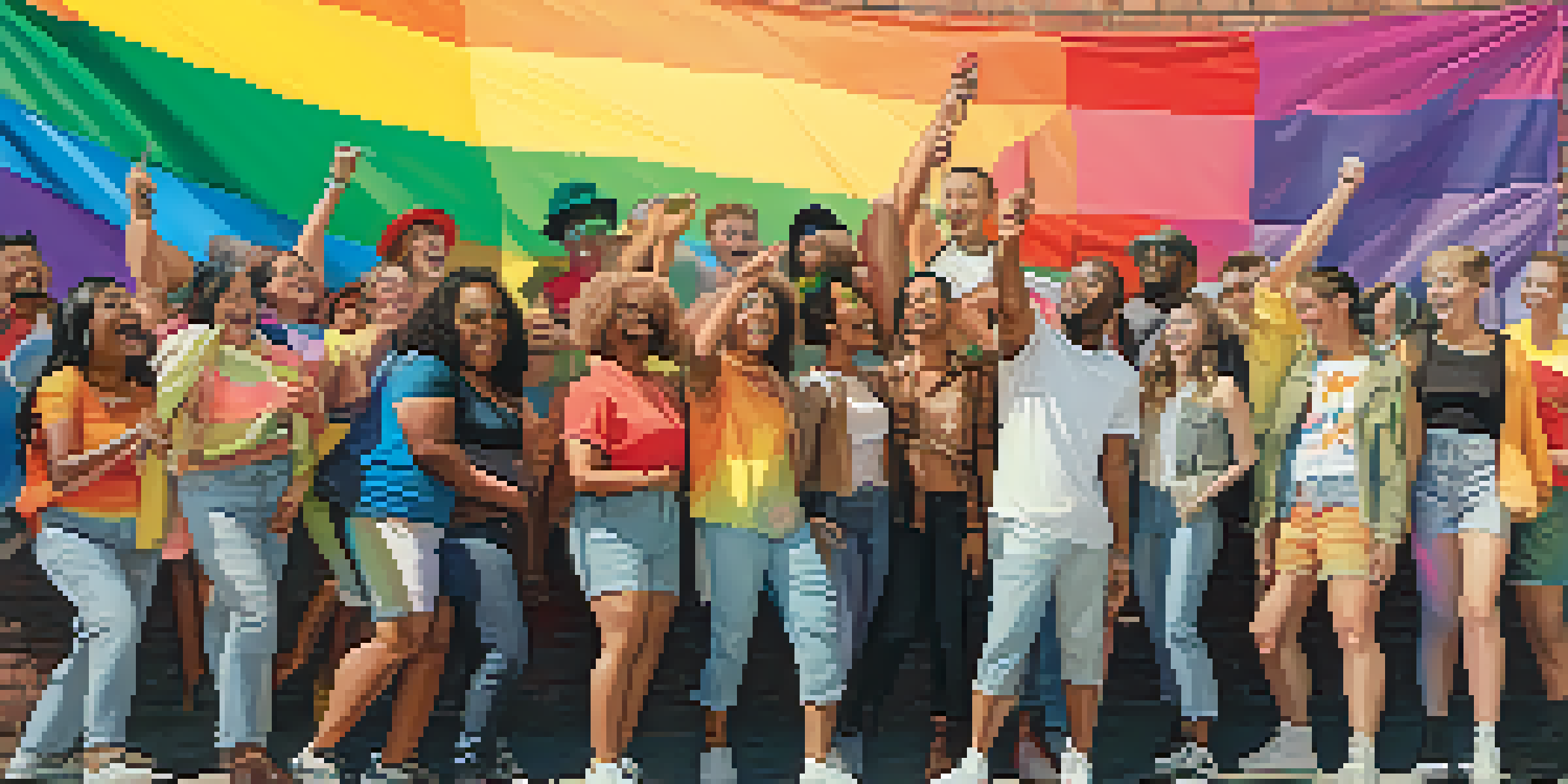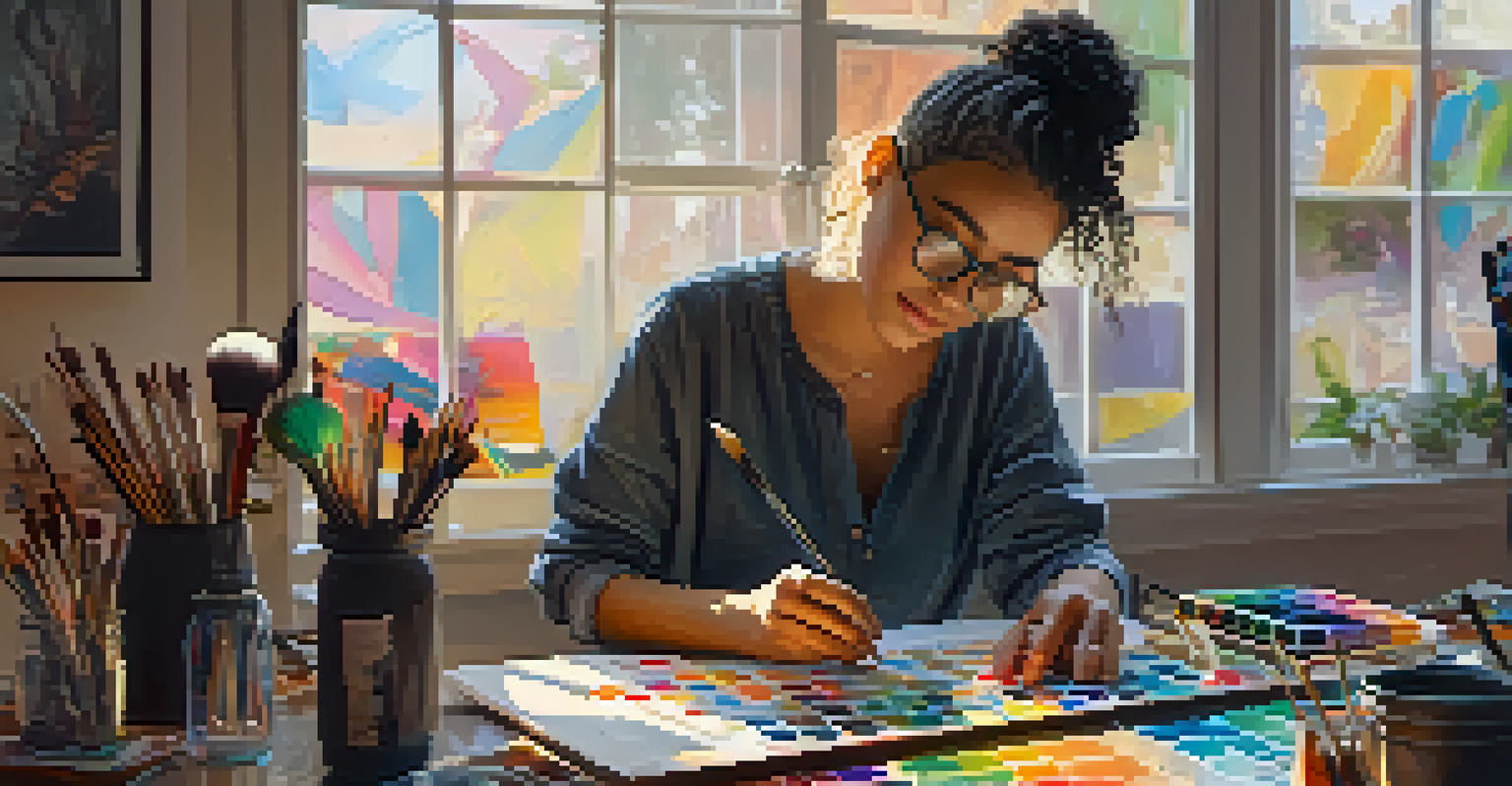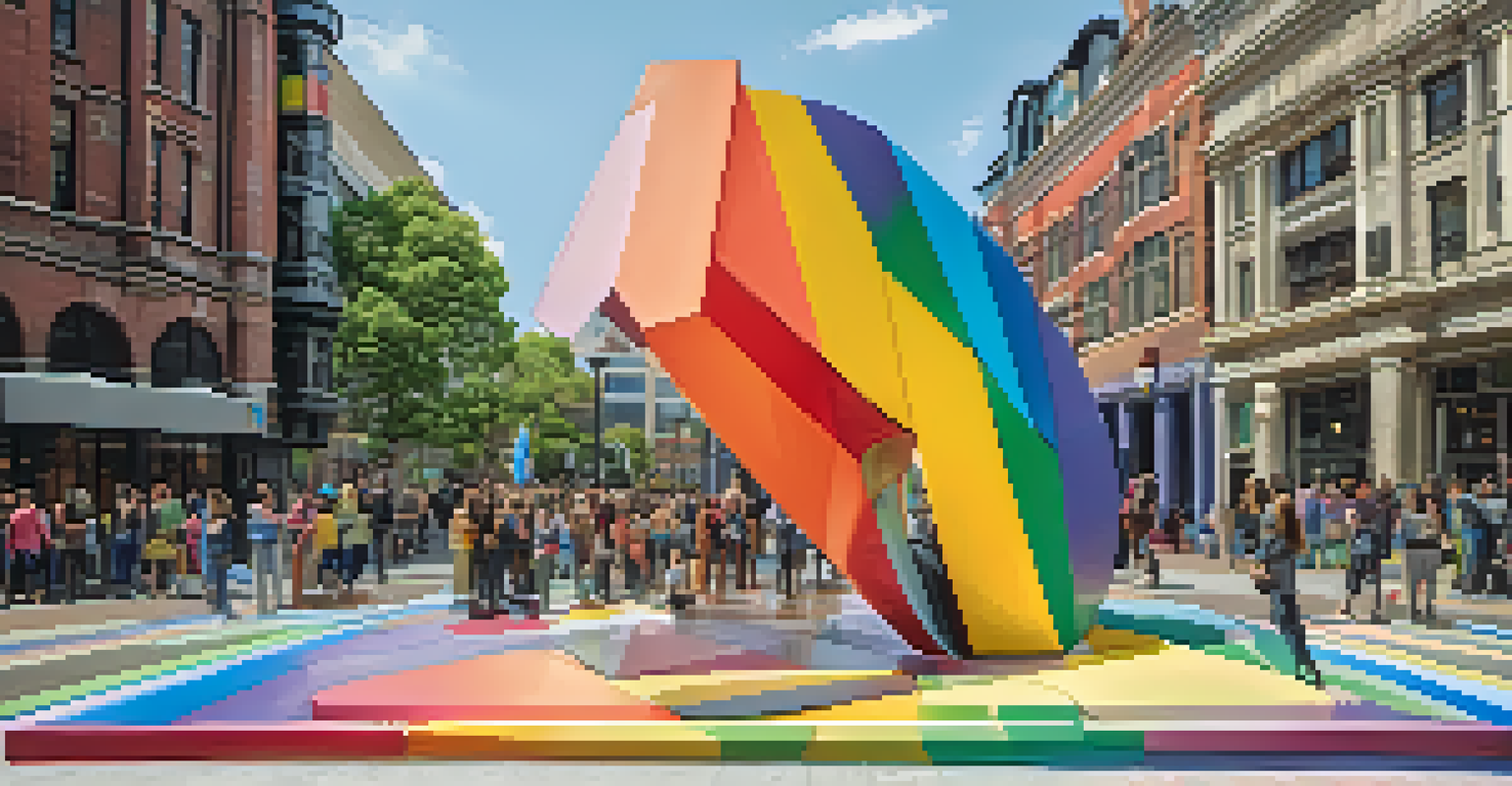Art and the LGBTQ+ Movement: Expressions of Identity and Change

The Historical Context of LGBTQ+ Art
Art has long been a powerful medium for expressing identity, and for the LGBTQ+ community, it has served as both a refuge and a battleground. From the early 20th century, artists began to use their work to challenge societal norms and convey their experiences. This historical context is essential to understanding how art has evolved alongside the LGBTQ+ movement, shaping and reflecting the struggles for rights and recognition.
Art is a reflection of who we are, and it has the power to change how we see the world.
In the wake of events like the Stonewall Riots in 1969, artists harnessed their creativity to address issues like discrimination and violence. Their work often became a form of activism, raising awareness and fostering solidarity within the community. For instance, artists like Keith Haring and Andy Warhol used their platforms to advocate for LGBTQ+ rights while also creating visually striking pieces that captured the spirit of the times.
As we delve into the art of this movement, it's crucial to recognize how these historical moments influenced not just the artists, but also the broader cultural landscape. The intersection of art and activism has created a rich tapestry of expression that continues to inspire new generations of artists today.
Art as a Reflection of Identity
For many LGBTQ+ artists, their work serves as a direct expression of their identity. Whether through painting, sculpture, or performance, these creators often explore themes of love, desire, and belonging in ways that resonate deeply with their personal experiences. This exploration not only validates their own identities but also provides a sense of connection to others who may feel marginalized.

Take the vibrant works of Frida Kahlo, for example; her self-portraits often blur the lines of gender and sexuality, inviting viewers to see the world through her unique lens. This deeply personal approach allows audiences to engage with complex identities in a relatable way. By sharing their stories, LGBTQ+ artists foster empathy and understanding, bridging gaps between different communities.
Art as Activism and Advocacy
LGBTQ+ artists use their work to address social issues and inspire action, transforming personal stories into powerful movements for change.
Moreover, this reflection of identity in art can also challenge traditional notions of gender and sexuality. By pushing boundaries and experimenting with form and content, artists encourage society to rethink preconceived notions about what it means to be part of the LGBTQ+ community.
Art as a Catalyst for Change
Art can be a powerful catalyst for social change, and the LGBTQ+ movement has harnessed this potential to advocate for rights and representation. Through provocative imagery and thought-provoking performances, artists have drawn attention to injustices faced by the community. This activism often transcends the art world, sparking conversations that lead to real-world impact.
The artist is the creator of beautiful things. To reveal art and conceal the artist is art's aim.
Consider the AIDS Memorial Quilt, a massive art installation that memorializes those lost to the AIDS crisis. Each patch tells a personal story, transforming individual grief into collective action and awareness. The quilt not only honors lives lost but also serves as a poignant reminder of the ongoing fight for LGBTQ+ health rights.
By using art to address issues like equality and representation, these creators inspire activism and encourage audiences to engage with important social issues. The dialogue initiated by their work can lead to tangible changes in legislation, public perception, and community support.
The Role of Public Art in LGBTQ+ Visibility
Public art plays a crucial role in elevating LGBTQ+ visibility and fostering a sense of community. Murals, installations, and sculptures in urban spaces often celebrate diversity and challenge heteronormative narratives. These works invite passersby to reflect on their own identities and experiences, creating a shared space for dialogue and understanding.
For instance, the iconic rainbow crosswalks in cities like San Francisco and Sydney serve as a vibrant symbol of pride and inclusivity. These bold statements not only beautify the streets but also remind the public of the ongoing fight for LGBTQ+ rights. Such installations create a sense of belonging and affirmation for those within the community while educating those outside of it.
Intersectionality Enhances Representation
By embracing diverse identities, LGBTQ+ artists create richer dialogues that highlight the complexities of their experiences and strengthen community solidarity.
Moreover, public art can provoke necessary conversations about acceptance and equality. By displaying diverse representations in accessible spaces, these artworks challenge societal norms and encourage viewers to reconsider their perspectives on gender and sexuality.
Digital Art and the LGBTQ+ Movement
In the digital age, art has found new platforms and audiences, allowing LGBTQ+ artists to reach wider communities than ever before. Social media, websites, and virtual exhibitions enable creators to showcase their work and share their messages with the world. This democratization of art has been particularly empowering for marginalized voices within the LGBTQ+ community.
For example, platforms like Instagram have become hotspots for LGBTQ+ artists to display their work and connect with like-minded individuals. The visual nature of these platforms allows artists to create engaging content that resonates with a global audience. This visibility can lead to increased support, collaboration, and advocacy for LGBTQ+ issues.
Additionally, digital art offers unique opportunities for experimentation and innovation. Artists can play with multimedia and interactive experiences, pushing boundaries of traditional art forms. This evolution not only reflects the changing landscape of the LGBTQ+ movement but also inspires new ways of thinking about identity and expression.
Intersectionality in LGBTQ+ Art
Intersectionality is a critical concept in understanding the diverse experiences within the LGBTQ+ community. Artists often draw from their intersecting identities—such as race, gender, and class—to create work that speaks to the complexities of their lived experiences. This approach enriches the dialogue around representation and inclusivity in art.
For example, artists like Zanele Muholi use photography to capture the lives of Black LGBTQ+ individuals, challenging conventional narratives and highlighting the unique struggles faced by these communities. By centering their work on intersectional identities, these creators amplify marginalized voices and encourage a broader understanding of the LGBTQ+ experience.
Digital Platforms Expand Visibility
The rise of digital art and social media allows LGBTQ+ artists to reach broader audiences, facilitating connection and advocacy for their causes.
As we explore the intersectionality in LGBTQ+ art, it becomes clear that embracing diverse perspectives strengthens the movement as a whole. This inclusive approach fosters solidarity and encourages collaboration among artists and activists from various backgrounds, ultimately enriching the cultural landscape.
Future Directions for LGBTQ+ Art and Activism
Looking ahead, the relationship between art and the LGBTQ+ movement is poised for continued evolution. As new generations of artists emerge, they bring fresh perspectives and innovative ideas that challenge the status quo. This dynamic shift will likely lead to even more diverse expressions of identity and activism within the art world.
Moreover, the ongoing fight for LGBTQ+ rights and representation ensures that art will remain a vital tool for advocacy. Artists will continue to respond to contemporary issues, using their work to raise awareness and inspire action. This commitment to social change will not only benefit the LGBTQ+ community but also encourage broader conversations about equity and justice.

Ultimately, the future of LGBTQ+ art and activism lies in its ability to adapt and respond to the needs of the community. By fostering collaboration, embracing diverse voices, and leveraging new technologies, artists can create impactful work that resonates with audiences and drives meaningful change.